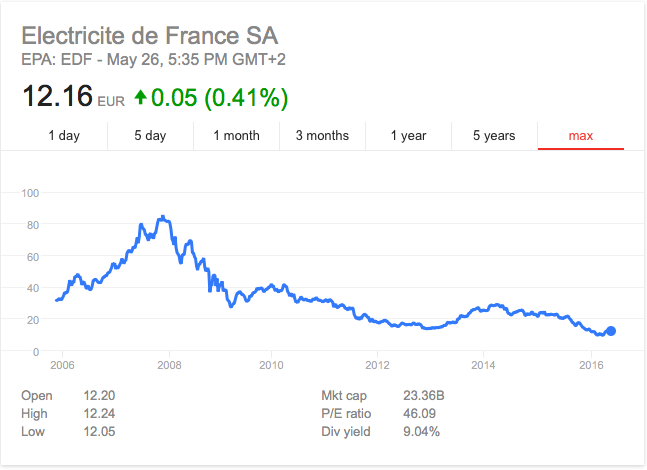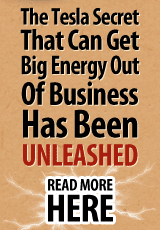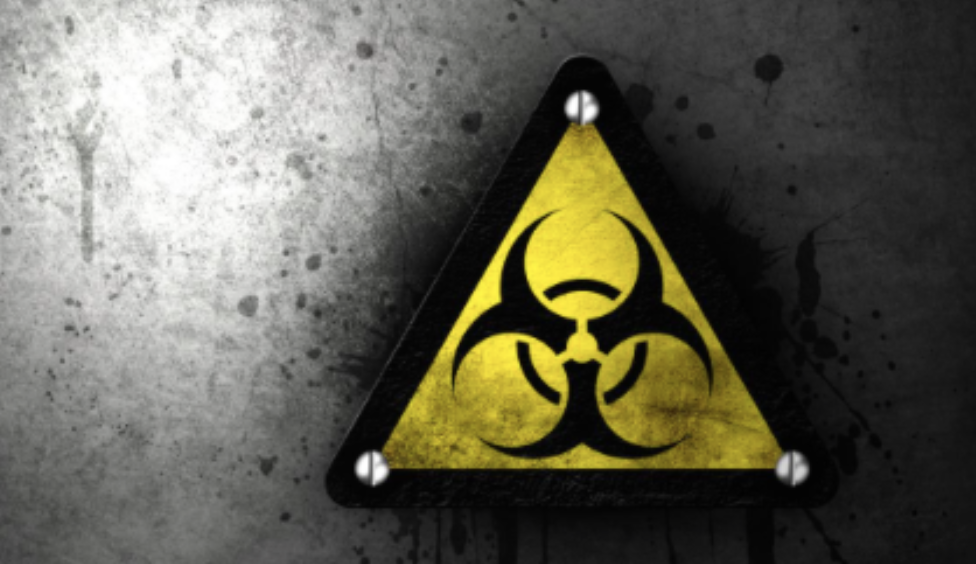One of the biggest scandals of our time is heading towards Britain. At the heart of Conservative energy policy is a white elephant of epic proportions – the Hinkley Point Nuclear power station in Somerset. You may have read something about it – but probably not this.
This power station has been described as the most expensive single “thing” on earth, although other power projects such as energy ports come even more expensive. Originally budgeted to cost around £14 billion three years ago, then £18 billion last year and revised up to nearly £22 billion this year. The EU Commission has estimated its final cost to be £24 billion.
Electricité de France or EDF the French state owned energy company is the biggest stakeholder. The project to build this power station is more expensive than the entire market capitalisation value of EDF and is effectively one huge gamble, and a gamble in more ways than one.
The Financial Times reported that the French Economy Minister Emmanuel Macron said that he “had every confidence that a final investment decision would be made ‘rapidly’ after a consultation with the central works committee of EDF.” He also happened to point out that EDF would not guarantee delivery date of 2025 – already estimated to be 8 years behind delivery date.
In the same article the French unions “have sought a delay of two to three years to the scheme, after EDF’s chief financial officer quit earlier this year, warning that the large investment could bring down the state-owned utility.”
Trade union representatives hold six of the 18 seats on EDF’s board and have openly stated, “The trade unions are unlikely to give their blessing to the project in its current state”. The EDF chief executive Vincent de Rivaz also admitted to MPs that he did not know when a final decision on the project would be made.
The British government for their part have made guarantees on the price of energy output once operational. That price is currently a guarantee worth 300 per cent of current wholesale energy prices for the following 35 years and by the time of delivery, this could easily have escalated to 400 or 500 per cent as alternative power sources continue to get more cost effective. Britain’s power needs have declined 13 per cent in the last ten years, a trend that looks set to continue all over Europe.
Angus MacNeil, chair of the energy committee, said it represented “spectacularly bad value for bill payers in the UK”.
In the meantime, Moody’s the rating agency, has downgraded EDF not because of the financial strain the project is putting on the company but because the technology being used in the project has never been proven to work at all – ever – anywhere. Not one power station, anywhere in the world uses this technology and two currently under construction in France and Finland have dramatically failed.
This is highlighted in a Guardian report of March this year,
EDF has been building a European pressurised reactor (EPR) plant in Normandy, France. The latest EPR has been dreamed up by EDF in conjunction with its engineering partner Areva. It was meant to be a showcase to the world, allowing EDF and Areva to market and build these plants globally, not least at Hinkley in Somerset. But Normandy has turned into a nightmare project with endless delays, regulatory problems and cost overruns. The situation has been made worse by another scheme involving EPRs at Olkiluoto in Finland. This too has turned into a huge public relations embarrassment. It has been plagued with contract disputes, broken budgets and is 10 years behind schedule.
However, it appears the situation has just got much worse than that as the nuclear reactor manufacturer Areva has in fact gone bankrupt and the French government is now forcing EDF to take it over adding even more financial woes to the ever more stricken energy firm.
The share price for EDF has collapsed 80 per cent over recent years presenting its own problems. This was not helped by RBC Capital Markets who said: “To proceed with Hinkley Point C at this juncture would be verging on insanity”.
 In a desperate attempt to help EDF’s financial position, it has in turn said it is willing to sell a bundle of €6bn worth of assets to raise cash. And who turned out to be the only buyer – the French state. This has caused energy companies from Austria, Luxembourg and Germany to threaten legal challenges as it is tantamount to unlawful state aid according to EU rules.
In a desperate attempt to help EDF’s financial position, it has in turn said it is willing to sell a bundle of €6bn worth of assets to raise cash. And who turned out to be the only buyer – the French state. This has caused energy companies from Austria, Luxembourg and Germany to threaten legal challenges as it is tantamount to unlawful state aid according to EU rules.
The Chinese have been beckoned as investor of last resort and you might wonder why they would want to be involved anyway in such a disaster. Well, for their investment, expected to be worth up to one third of the total project cost they want guarantees as well. However, they want payment even if the project fails, now or in the future, for whatever reason, including if no power is generated ever. And the British government on behalf of the taxpayer, has decided to give those guarantees.
 You would think that this was all bad enough. Not so! It appears that nuclear power stations around the world have been falsifying safety certificates and documents for nuclear reactor components for some time now. In fact, of the 400 falsified certificates known to have been given to critical reactor components, 50 are still in operation, a risk that humanity should not be taking given the damage that Fukushima is currently doing to Japan and the Pacific Ocean.
You would think that this was all bad enough. Not so! It appears that nuclear power stations around the world have been falsifying safety certificates and documents for nuclear reactor components for some time now. In fact, of the 400 falsified certificates known to have been given to critical reactor components, 50 are still in operation, a risk that humanity should not be taking given the damage that Fukushima is currently doing to Japan and the Pacific Ocean.
If history and building nuclear reactors is anything to go by, a sane person might think to steer clear. America is the world’s largest producer of nuclear energy with 99 power stations in operation producing one quarter of energy needs. For 75 of those nuclear power reactors built, cost overruns averaged 207 percent. Over-commitment to nuclear power brought about the financial collapse of the Washington Public Power Supply System, a public agency which undertook to build five large nuclear power plants. A decade later, cost overruns and delays, along with a slowing of electricity demand growth, led to cancellation of two WPPSS plants and a construction halt on two others. Moreover, WPPSS defaulted on $2.25 billion of municipal bonds, which is still the largest municipal bond default in U.S. history. The court case that followed took nearly a decade to resolve.
To make matters worse, of the 253 nuclear power reactors originally ordered in the United States from 1953 to 2008, 48 percent were cancelled, 11 percent were prematurely shut down, 14 percent experienced at least a one-year-or-more outage, and only 27 percent are operating without having a year-plus outage. Thus, only about one fourth of those ordered, or about half of those completed, are still operating and have proved relatively reliable. Many are now considered at high risk from acts of terrorism.
Again, history should teach us some lessons, especially of untried, untested and unknown technology in this particular industry. One of the greatest cover-ups of our time is the disaster at Chernobyl and Fukushima. The former has already killed one million and will continue killing many more so for some time yet, the latter has the potential to eclipse even Chernobyl as it is three times in scale according to the foremost recognised expert in this area, Dr Helen Caldecott.
Once again, history helps to build a graphic picture of this scandal laden industry. From Global Research –
Thirty-five years ago, Dale G. Bridenbaugh and two of his colleagues at General Electric resigned from their jobs after becoming increasingly convinced that the nuclear reactor design they were reviewing (For the Fukushima plant) — the Mark 1 — was so flawed it could lead to a devastating accident. Questions persisted for decades about the ability of the Mark 1 to handle the immense pressures that would result if the reactor lost cooling power, and today that design is being put to the ultimate test in Japan. Five of the six reactors at the Fukushima Daiichi plant, which has been wracked since Friday’s (March 2011) earthquake with explosions and radiation leaks, are Mark 1s.
 The Nuclear Corruption report from Nautilus Institute tells us something else. “Fukushima will teach many lessons, but one that does not seem to have sunk in yet is the global link between nuclear power and corruption. There is plenty of evidence that the corruption, collusion and nepotism that characterized the Japanese “nuclear village” contributed to what former Japanese PM Kan Naoto called the “myth of nuclear safety” in his country. Yet, this is far from being something peculiar to Japan with its squirrelly politics and industry-regulator-politics with feet happily inter-twined under the kotatsu.”
The Nuclear Corruption report from Nautilus Institute tells us something else. “Fukushima will teach many lessons, but one that does not seem to have sunk in yet is the global link between nuclear power and corruption. There is plenty of evidence that the corruption, collusion and nepotism that characterized the Japanese “nuclear village” contributed to what former Japanese PM Kan Naoto called the “myth of nuclear safety” in his country. Yet, this is far from being something peculiar to Japan with its squirrelly politics and industry-regulator-politics with feet happily inter-twined under the kotatsu.”
Aside of the enormous costs of construction is decommissioning, which for this plant is unknown but certainly running into the £billions. This is a 100 per cent liability cost to the British taxpayer. In addition, one of the major costs is the safe disposal of highly radioactive waste, which will never be safe and most of which is held in temporary storage at the Sellafield reprocessing facility in Cumbria. Home to “the most hazardous industrial building in western Europe” according to George Beveridge, Sellafield’s deputy managing director. It houses an ageing cooling pond whose contents is not entirely known, even to the managers at the site, being a collection of spent fuel rods and other reactor parts from Britain’s earliest experiments into nuclear power. The contents of this site is not known and is too radioactive to be properly investigated as the technology does exist to do so. Cleanup of this site would also run into £billions, again, a number that is actually unknown.
The British government is in effect guaranteeing enormous profits for foreign state organisations and underwriting huge losses on unproven dangerous technology that has so far failed, has a history of being massively over-budget, way behind target delivery by at least a decade and presents the country with a strategic threat both in terms of energy security and the wellbeing of its people.
Knowing all of the above, there is no logic or sense for authorising the building of the world’s most expensive “thing” – unless of course there’s something in it for the decision makers.
Graham Vanbergen writes for truepublica.org.uk


For all of us who protested nuclear power as a choice during the past 50+ years, and for anyone who ever looks around at the world rather than just at their personal device (phone, tablet, etc.), to have confirmation that so many safety certifications are false while people are still trying to build a “Safe” nuclear power plant, it sure looks like we chose to intentionally destroy the Earth. The Fukushima disaster has destroyed 1/3 of the Pacific Ocean. The millions of tons of floating plastic and discarded nets have destroyed another 1/3 of the Pacific. The English fought off their opponents in France for hundreds of years, and now France will destroy itself as it destroys the English with yet another disastrous nuclear power plant meant to bankrupt France and England for the next 100 years. Where will they evacuate all of those who will need to be removed from these toxic areas? To rely on an energy company that has already shown total failure in Normandy and Finland is moronic. Drive around England, folks, there are nuclear power plants all over the place, and along every primary river. The nuclear power industry is inept, incompetent and out of their depth. They cannot fix minor problems much less major problems. A bunch of selfish, short-sighted politicians got paid off to rubber stamp the installation of these worthless disasters. There has never ever been any accountability where nuclear energy is concerned. Not one greedy, corrupt politician or business executive has been held accountable. Not one greedy, corrupt scientist has been held accountable. The best that happens is a few people who know they’d never sleep again have resigned, and everyone else closed the book on their serious concerns and moved on. We need to stop handing our futures to the inept morons who make their decisions on our behalf based on the pay offs they’ll get. We need to stop handing our futures to the greedy executives that can’t think beyond their financial needs this month, ie. the expensive cars, multiple vacation homes, outrageous conventions, expensive underaged prostitutes, fancy parties, etc.
I don’t know much – but it seems that this kind of money would be better off developing solar or wind or geo thermal.
I mean a billion here a billion there- that would go a long ways to employ other safer means – even coal (no offense to coal miners – I heart you guys) would be safer. Another gold collar scam, no doubt.
BTW: I agree with janus.
It is all thought out as this will be twinned with Japanese Fukushima that is making the World Radio Active though am not sure which Radio Programs that I will tune into?
World leadership is decidedly weak, however, it does have one plus in it’s corner and that is “Incredible incompetence”. Their future is sealed in a casket of stupidity. Fools rush in, where angels fear to tread. They shall reap what they have sown.
Clean burn coal anyone? China is going this way, and getting cleaner all the time.